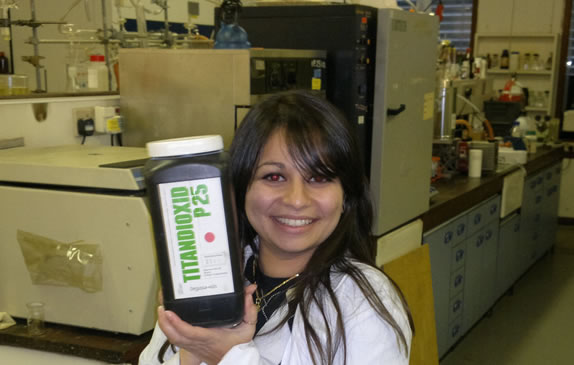#sheblindedmewithscience – meet Suze Kundu
This is the final blog in a series by the five ScienceGrrls who featured in “She Blinded Me With Science”. If you haven’t yet seen the video, it’s here and all sales proceeds are being donated to ScienceGrrl!
 I’m Dr Suze Kundu and I’m a Teaching Fellow in the Department of Materials at Imperial College London. I’m really lucky because I get to spend time interacting with both our undergraduate and postgraduate students, do some teaching, help organise the labs, and share my passion for the novel science that we do in the Department through Outreach and Public Engagement, all as part of my job.
I’m Dr Suze Kundu and I’m a Teaching Fellow in the Department of Materials at Imperial College London. I’m really lucky because I get to spend time interacting with both our undergraduate and postgraduate students, do some teaching, help organise the labs, and share my passion for the novel science that we do in the Department through Outreach and Public Engagement, all as part of my job.
Filming for the music video was really good fun! I hope that it has showcased what Materials Science and Engineering is. Despite having a reputation for being a boy’s subject, it is actually much more balanced, and is a really fun and useful subject to study as we are actively solving many global challenges. It can take you down any path you choose, and a subject through which you can be scientific, engineer things and also involve elements of art and design too.
[fve]https://www.youtube.com/watch?v=mtOcYdSIXXw[/fve]
The research I showcase in the video is based on an area known as Artificial Photosynthesis. It’s an area of materials science and engineering that is inspired by nature, and a plant’s ability to capture sunlight energy and use it to excite an electron that can go on to split water. The chemical formula for water is H2O, which means that in a water molecule you find two atoms of hydrogen and one atom of oxygen. We can spilt these water molecules and liberate hydrogen and oxygen as gases. If you drop a 9V battery into a glass of water, you will see bubbles of these gases rising from the two terminals. If you collected the gas, you would be able to see that there is twice as much hydrogen being evolved than oxygen, which makes sense when we look at the ratios of the two elements in our formula for water. It takes a lot of energy to do this however, this research relies on a middleman to reduce the energy required to achieve this – Titanium Dioxide.
Titanium Dioxide is everywhere, from sweets to washing powder to paints. It is a really white powder and it can also get energetically excited when exposed to high energy sunlight – the ultraviolet bit that can make our skin burn if we are not careful. Once excited, it wants to relax again, and so transfers that energy onto the water molecules. It is enough for them to split and generate hydrogen and oxygen. We can collect the hydrogen and use it as a fuel. When we burn hydrogen, we are reacting it with oxygen again, and so produce water as our product of combustion while releasing lots of heat – three times more than we would release if we burned the same amount of methane. We can even incorporate a fuel cell to generate electricity from burning the hydrogen.
Titanium dioxide is cheap, and doesn’t need lots of maintenance, so we are creating a cheap and sustainable way of making a solar fuel, which could one day replace petrol, oil and coal. We will be able to fill our cars up with water, which means that fuel will be cheaper, cleaner and friendlier to the environment, and sustainable, which are all really important things to consider.

Meet titanium dioxide!
Capturing UV light is great, but the process would be more efficient if we could capture even more of the sunlight reaching the Earth. By introducing nanoparticles of silver and gold into the titanium dioxide the electronic properties change, allowing it to be excited by lower energy, longer wavelength light, capturing a larger proportion of the sunlight, increasing efficiency.
Dr Sujata Kundu
Materials Chemist and Science Communicator @FunSizeSuze
